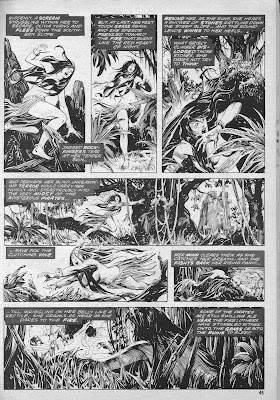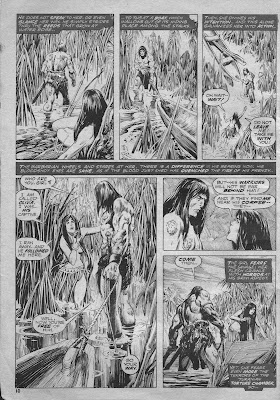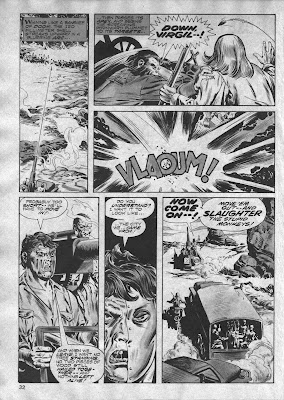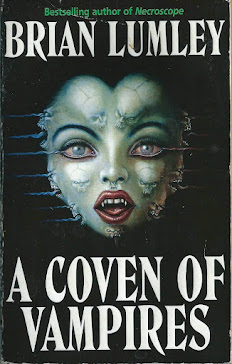Jane
by Eric White
oil on canvas, 60 x 40 inches, 2014
Monday, February 27, 2017
Friday, February 24, 2017
Book Review: The Drawing of the Dark
Book Review: 'The Drawing of the Dark' by Tim Powers
5 / 5 Stars
‘The Drawing of the Dark’ was originally published in the US in 1979; this Granada (UK) paperback version (383 pp) was published in 1981. The cover art is by Gino D’Achille.
The novel is set in 1529; as it opens, it’s a warm night in Venice, and the middle-aged Irish soldier of fortune Brian Duffy is contemplating what to do with his life. Two and a-half years earlier, Duffy had survived fighting on the losing side during the battle against the Turks at Mohacs, Hungary; now, rumors are swirling that Suleiman the Magnificent is mustering a great host to invade, and overthrow, Austria.
After a fracas with some Venetian dandies, Duffy makes the acquaintance of an elderly eccentric named Aurelianus, who assigns a task to the Irishman: travel to Vienna and serve as the bouncer at the Zimmerman Inn, famous for its brewery. Persuaded by the handsome reward Aurelianus is offering, Duffy agrees.
While en route to Venice, Duffy gradually becomes aware that working for Aurelianus means encountering the supernatural. Ghosts and spirits, and more malevolent entities, confront Duffy on his journey, and when he arrives in Vienna and the Zimmerman Inn, it is with a sense of relief.
Duffy has barely settled in as the Inn’s bouncer when it becomes apparent that momentous events are centering on the city, for Suleiman and his army aim to lay siege to Vienna. Taking up the mercenary life once again, Duffy joins the city’s defenders – a polyglot crew of Germans, Spaniards, and Vikings - in their struggle to resist the Turkish onslaught.
As the Fall of 1529 unfolds, Brian Duffy will discover that the siege brings with it a clash of occult forces that has been centuries in the making. And unless Brian and Aurelianus can defeat the machinations of Suleiman’s chief wizard Ibrahim, Vienna will capitulate………and with its fall, the future of Western civilization will be in doubt……….
When it appeared in 1979, ‘The Drawing of the Dark’ was a novel that really didn’t fit into any of the sub-genres of sf. It lacked the technological emphasis of Steampunk, and its firm basis in historical fact meant it didn't neatly fit into the category of heroic fantasy, or even fantasy in general. Conversely, its fantastical elements kept it from being categorized as historical fiction. Even today, I can’t come up with a category that ‘Drawing’ fits into.
Be that as it may, ‘Drawing’ is a well-written novel, with a clean, direct prose style and an entertaining cast of characters. Although there is an inevitable slowing of the pace of the narrative in the middle chapters (the book could have benefited from being 50 pages shorter) the final chapters are engrossing and the novel’s ending is uncontrived.
In fact, it’s markedly superior to the works of Gene Wolfe, whose novels in the late 70s and early 80s belonged to the same genre of ‘postmodern fantasy’ as 'Drawing', but received considerably more attention.
Copies of ‘The Drawing of the Dark’ are readily available from your usual online retailers. This one is well worth picking up.
5 / 5 Stars
‘The Drawing of the Dark’ was originally published in the US in 1979; this Granada (UK) paperback version (383 pp) was published in 1981. The cover art is by Gino D’Achille.
The novel is set in 1529; as it opens, it’s a warm night in Venice, and the middle-aged Irish soldier of fortune Brian Duffy is contemplating what to do with his life. Two and a-half years earlier, Duffy had survived fighting on the losing side during the battle against the Turks at Mohacs, Hungary; now, rumors are swirling that Suleiman the Magnificent is mustering a great host to invade, and overthrow, Austria.
After a fracas with some Venetian dandies, Duffy makes the acquaintance of an elderly eccentric named Aurelianus, who assigns a task to the Irishman: travel to Vienna and serve as the bouncer at the Zimmerman Inn, famous for its brewery. Persuaded by the handsome reward Aurelianus is offering, Duffy agrees.
While en route to Venice, Duffy gradually becomes aware that working for Aurelianus means encountering the supernatural. Ghosts and spirits, and more malevolent entities, confront Duffy on his journey, and when he arrives in Vienna and the Zimmerman Inn, it is with a sense of relief.
Duffy has barely settled in as the Inn’s bouncer when it becomes apparent that momentous events are centering on the city, for Suleiman and his army aim to lay siege to Vienna. Taking up the mercenary life once again, Duffy joins the city’s defenders – a polyglot crew of Germans, Spaniards, and Vikings - in their struggle to resist the Turkish onslaught.
As the Fall of 1529 unfolds, Brian Duffy will discover that the siege brings with it a clash of occult forces that has been centuries in the making. And unless Brian and Aurelianus can defeat the machinations of Suleiman’s chief wizard Ibrahim, Vienna will capitulate………and with its fall, the future of Western civilization will be in doubt……….
When it appeared in 1979, ‘The Drawing of the Dark’ was a novel that really didn’t fit into any of the sub-genres of sf. It lacked the technological emphasis of Steampunk, and its firm basis in historical fact meant it didn't neatly fit into the category of heroic fantasy, or even fantasy in general. Conversely, its fantastical elements kept it from being categorized as historical fiction. Even today, I can’t come up with a category that ‘Drawing’ fits into.
Be that as it may, ‘Drawing’ is a well-written novel, with a clean, direct prose style and an entertaining cast of characters. Although there is an inevitable slowing of the pace of the narrative in the middle chapters (the book could have benefited from being 50 pages shorter) the final chapters are engrossing and the novel’s ending is uncontrived.
In fact, it’s markedly superior to the works of Gene Wolfe, whose novels in the late 70s and early 80s belonged to the same genre of ‘postmodern fantasy’ as 'Drawing', but received considerably more attention.
Copies of ‘The Drawing of the Dark’ are readily available from your usual online retailers. This one is well worth picking up.
Labels:
The Drawing of the Dark
Tuesday, February 21, 2017
Iron Shadows in the Moon Part Two
Iron Shadows in the Moon
Part Two
By John Buscema and Alfred Alcala (art) and Roy Thomas (story)
The conclusion of 'Iron Shadows in the Moon' from Savage Sword of Conan issue 4 (February 1975).
Part Two
By John Buscema and Alfred Alcala (art) and Roy Thomas (story)
The conclusion of 'Iron Shadows in the Moon' from Savage Sword of Conan issue 4 (February 1975).
Saturday, February 18, 2017
Iron Shadows in the Moon Part One
Iron Shadows in the Moon
Part One
By John Buscema and Alfred Alcala (art) and Roy Thomas (story)
One of the most impressive pieces of artwork in a 70s comic is that created by John Buscema and Alfredo Alcala for the February 1975 (issue No. 4) of The Savage Sword of Conan.
It's based on 'Shadows in the Moonlight', a Robert E. Howard story that appeared in Weird Tales in April,1934.
Althought the copy of SSoC that I scanned 'Shadows' from is beat up and browning from age, when scanned at 300 dpi, the artwork holds up very well......in my opinion, very little artwork presented in comics since, has approached the level of skill displayed in this one issue of a comic magazine that was printed on cheap-grade paper.
To my eyes, it looks like Buscema supplied the breakdowns, while the majority of the 'real' artwork was done by Alcala, as his distinctive pen-and-ink style is apparent in every panel.
I'm going to post 'Iron Shadows in the Moon' in two parts; part one is below, and part two will be in my next blog post.
Part One
By John Buscema and Alfred Alcala (art) and Roy Thomas (story)
One of the most impressive pieces of artwork in a 70s comic is that created by John Buscema and Alfredo Alcala for the February 1975 (issue No. 4) of The Savage Sword of Conan.
It's based on 'Shadows in the Moonlight', a Robert E. Howard story that appeared in Weird Tales in April,1934.
Althought the copy of SSoC that I scanned 'Shadows' from is beat up and browning from age, when scanned at 300 dpi, the artwork holds up very well......in my opinion, very little artwork presented in comics since, has approached the level of skill displayed in this one issue of a comic magazine that was printed on cheap-grade paper.
To my eyes, it looks like Buscema supplied the breakdowns, while the majority of the 'real' artwork was done by Alcala, as his distinctive pen-and-ink style is apparent in every panel.
I'm going to post 'Iron Shadows in the Moon' in two parts; part one is below, and part two will be in my next blog post.
Thursday, February 16, 2017
Battle for the Planet of the Apes Part VI
Battle for the Planet of the Apes
Part VI of VII
by Doug Moench (script) and Virgil Redondo (art)
from Planet of the Apes (Marvel / Curtis) No. 27, December 1976
The copy of the magazine I scanned these pages from was water-damaged and the pages are warped, something that a scan at 300 dpi makes all too clear.
However, the high quality of the artwork from Virgil Redondo is apparent despite the defects in the pages.
Part One is here.
Part Two is here.
Part Three is here.
Part Four is here.
Part Five is here.
Part VI of VII
by Doug Moench (script) and Virgil Redondo (art)
from Planet of the Apes (Marvel / Curtis) No. 27, December 1976
The copy of the magazine I scanned these pages from was water-damaged and the pages are warped, something that a scan at 300 dpi makes all too clear.
However, the high quality of the artwork from Virgil Redondo is apparent despite the defects in the pages.
Part One is here.
Part Two is here.
Part Three is here.
Part Four is here.
Part Five is here.
Subscribe to:
Posts (Atom)






























































































